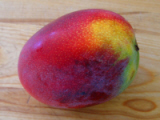Allergic Reaction from Mangos

We are in the full of mango season! The trees are filled with tons of delicious, sweet mangos falling to the ground in the dozens. Did you know that mangos can cause a skin allergy if they are not properly washed? A number of people have already experienced this. The following is an article by Zenaida Serrano, that was published in the Honolulu Advertiser . It explains how this happens: File these under things that may give you a severe rash: Poison ivy, poison oak and ... hold up ... mango? Blame it on a chemical called urushiol, which is found in the oil of mango sap.
While there are different types of reactions to mango, the most common is an itchy skin condition called allergic contact dermatitis, caused by an allergic reaction to material in contact with the skin, Sweet said.
But the good news about this type of allergy is that the fruit itself is still safe to eat. It's the oil in the sap found outside the fruit that causes allergic contact dermatitis among certain people, he said.
When those who are allergic come in contact with the sap — whether by touching a mango tree's leaves, bark or stems, or the skin of the fruit — it may result in itching, redness, blisters and/or hives. However, reaction is not immediate, often happening 12 to 24 hours after contact, even up to 48 hours later.
If left untreated, the condition can last one to three weeks before it resolves itself. The rash may be treated with an over-the-counter 1 percent cortisone cream, Sweet said.
If the rash spreads or becomes intolerable, see a doctor who could prescribe a potent steriod cream or cortisone pills, such as prednisone.
Sweet offers these tips to those who may be prone to mango allergies, specifically allergic contact dermatitis:
- Avoid contact with the sap of a mango tree. Don't climb the tree, pick its fruits or prune its branches. Parents may also want to watch their children around mango trees and branches.
- To handle unpeeled mangoes, wear disposable plastic gloves. Better yet, have someone else clean and cut it for you.
- If you get sap on you, quickly wash it off using dish detergent. Anecdotally, Sweet said, Joy works best. While he isn't exactly sure why this works, he suspects dish detergent rids the allergy-causing oil in the sap better than regular soap and water.
- If you develop an allergic reaction to the sap, don't use benadryl cream, which can irritate the condition or make it worse. For an over-the-counter treatment, use cortisone cream.
